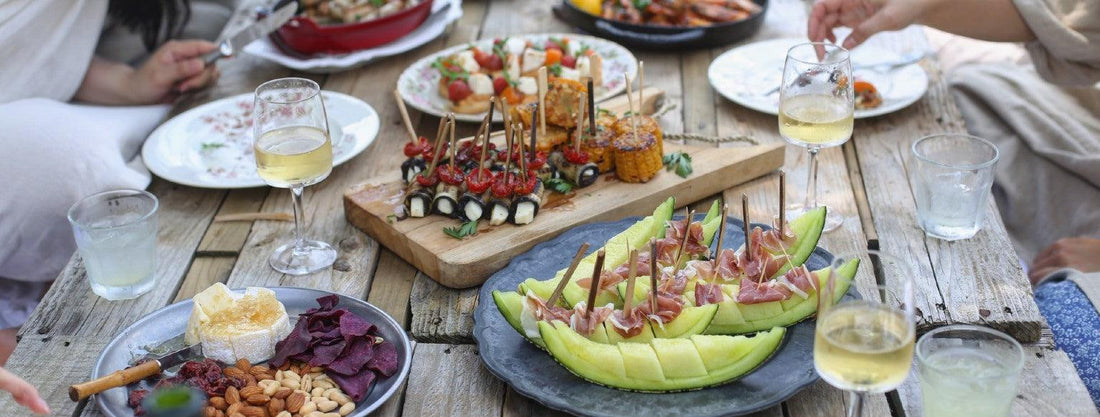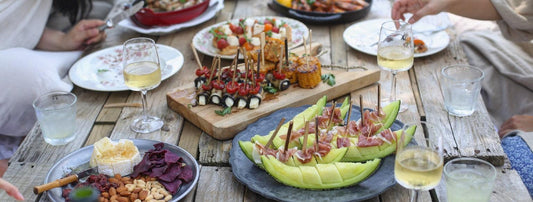Are you a wine enthusiast who wants to unlock the secrets of perfect wine and food pairings? Look no further! In this comprehensive guide, we will explore the fascinating world of wine and food pairing, providing you with all the essential tips and tricks to elevate your dining experience. Whether you're a red wine lover, a white wine aficionado, or simply curious about exploring new flavour combinations, this article will be your ultimate resource.
Understanding Wine and Food Pairing
Pairing wine with food is an art that can enhance the flavours and enjoyment of both. While some may find the prospect intimidating, it doesn't have to be. With a basic understanding of the principles behind wine and food pairing, you can confidently create harmonious combinations that will impress your guests and elevate any meal.
The Science of Wine and Food Pairing
To truly appreciate the art of wine and food pairing, it helps to understand the science behind it. The aromatic and flavour compounds in wine interact with the fat, protein, and carbohydrates in food as we eat. This interaction can either enhance or diminish the flavours of both the wine and the food. The goal is to create a balance and synergy between the two, where each element complements and improves the other.
Pairing Guidelines: Congruent vs. Complementary
When it comes to pairing wine and food, there are two main approaches: congruent and complementary pairings. Congruent pairings occur when there are many similarities between the flavour profiles of the wine and the food. For example, a light-bodied white wine with fresh seafood creates a congruent pairing, as both have delicate and subtle flavours. On the other hand, complementary pairings involve contrasting flavours that balance each other out. For instance, a bold and tannic red wine can complement the richness of a juicy steak.
The Importance of Balance
One key principle in wine and food pairing is achieving balance. A well-balanced pairing ensures that neither the wine nor the food overwhelms the other. The intensity of flavours, acidity, and sweetness of both elements should be taken into consideration. Strive for a harmonious combination where the flavours and textures complement each other, creating a memorable dining experience.
Pairing Wine with Food: A Comprehensive Guide
Now that we understand the fundamentals of wine and food pairing, let's dive into the specifics. In this section, we will explore various food categories and recommend wine pairings that will enhance the flavours of each dish. From starters to desserts, we have you covered.
Starters and Light Bites
Starters and light bites set the tone for a meal and can be a great opportunity to introduce your guests to exciting flavour combinations. When selecting wines for starters, consider their acidity, freshness, and versatility. Here are some classic pairings to inspire you:
-
Bruschetta with Tomato and Basil: The vibrant flavours of tomatoes and basil call for a crisp and refreshing white wine. A Sauvignon Blanc or a Pinot Grigio would be an excellent choice, as their citrusy and herbal notes complement the freshness of the bruschetta.
-
Smoked Salmon Canapés: The richness of smoked salmon pairs beautifully with a dry sparkling wine like Champagne or Prosecco. The effervescence cuts through the fattiness of the salmon, cleansing the palate and enhancing the flavours.
-
Cheese Platter: A cheese platter offers a myriad of flavours and textures. To complement the different cheeses, opt for a versatile wine like a Chardonnay or a light-bodied red wine such as a Pinot Noir. These wines have enough complexity to pair with a variety of cheeses, from creamy Brie to tangy goat cheese.
Soups and Salads
Soups and salads can be a refreshing start to a meal or serve as a light main course. When it comes to pairing wines with these dishes, consider the flavours and intensity of the ingredients. Here are some delicious pairings to try:
-
Creamy Mushroom Soup: The earthy flavours of mushroom soup call for a wine with similar characteristics. A medium-bodied red wine like a Merlot or a light-bodied red like a Pinot Noir will complement the earthiness of the soup without overpowering it.
-
Caesar Salad: The combination of crisp romaine lettuce, tangy Caesar dressing, and Parmesan cheese requires a wine with enough acidity to cut through the richness. A dry white wine like a Chardonnay or a Sauvignon Blanc would be an excellent choice.
-
Gazpacho: This refreshing tomato-based cold soup is a summer favourite. Its bright and vibrant flavours pair well with a light and fruity red wine like a Beaujolais or a chilled Rosé.
Pasta and Pizza
Pasta and pizza dishes offer endless possibilities for wine pairings. The key is to consider the sauce, toppings, and overall flavour profile. Here are some classic pairings to inspire your next Italian feast:
-
Spaghetti Carbonara: The creamy and indulgent flavours of carbonara call for a wine with enough acidity to cut through the richness. A medium-bodied white wine like a Chardonnay or a dry Italian white wine such as Vermentino would be an excellent choice.
-
Margherita Pizza: The simplicity of a Margherita pizza with its fresh tomatoes, mozzarella, and basil pairs perfectly with a light-bodied red wine like a Chianti or a Barbera. The acidity of the wine complements the tanginess of the tomatoes and the creaminess of the cheese.
-
Pesto Pasta: The vibrant flavours of pesto demand a wine that can match its intensity. A crisp and herbaceous white wine like a Sauvignon Blanc or a dry Italian white wine such as a Verdicchio would be a delightful pairing.
Seafood and Fish
Seafood and fish dishes can be delicate or bold, and the choice of wine depends on the flavours and intensity of the dish. Here are some classic pairings to enhance your seafood dining experience:
-
Grilled Salmon: The rich and fatty flavours of grilled salmon call for a medium-bodied white wine like a Chardonnay or a Pinot Gris. These wines have enough structure to stand up to the salmon's flavours without overpowering them.
-
Oysters: Oysters are known for their briny and delicate flavours. A dry and crisp white wine like a Muscadet or a sparkling wine like Champagne would be an ideal pairing. The acidity and effervescence cleanse the palate and enhance the oysters' flavours.
-
Lobster: The succulent and buttery flavours of lobster deserve a wine that can match its richness. A full-bodied white wine like a White Burgundy or a buttery Chardonnay would be a perfect complement to the lobster's flavours.
Red Meat and Game
Red meat and game dishes often have bold flavours and require wines with enough structure and depth to stand up to them. Here are some classic pairings to elevate your meaty dishes:
-
Grilled Steak: The robust flavours of a grilled steak call for a full-bodied red wine with firm tannins. A Cabernet Sauvignon or a Syrah/Shiraz would be an excellent choice. The tannins in these wines help to soften the proteins in the meat and enhance its flavours.
-
Roast Lamb: The earthy and herbaceous flavours of roast lamb pair beautifully with a medium to full-bodied red wine like a Merlot or a Malbec. These wines have enough complexity to complement the lamb's flavours.
-
Game Birds: Game birds like duck or pheasant offer a unique and rich dining experience. A medium-bodied red wine like a Pinot Noir or a Zinfandel would be a delightful pairing. The fruity and spicy notes of these wines complement the game birds' flavours.
Cheese and Desserts
Cheese and desserts can be a delightful way to end a meal. When pairing wines with cheese and desserts, consider the sweetness and intensity of the flavours. Here are some classic pairings to satisfy your sweet tooth:
-
Blue Cheese: The pungent and salty flavours of blue cheese pair beautifully with a sweet and fortified wine like a Port or a Sauternes. The sweetness of the wine balances out the strong flavours of the cheese.
-
Chocolate Desserts: The rich and decadent flavours of chocolate desserts call for a wine with enough sweetness and depth. A late-harvest red wine like a Banyuls or a Ruby Port would be a perfect complement to chocolate.
-
Fruit-based Desserts: Fruit-based desserts like apple pie or peach cobbler require a wine that can match their sweetness and fruity flavours. A late-harvest white wine like a Riesling or a Moscato d'Asti would be an excellent choice.
Conclusion
Wine and food pairing is an art that can elevate any dining experience. By understanding the principles behind pairing, considering the flavours and intensity of both the wine and the food, and experimenting with different combinations, you can create harmonious and memorable meals. Whether you're enjoying a casual dinner or hosting a special occasion, the right wine and food pairing can take your meal to the next level. So, go ahead, explore the vast world of wine and food, and savour the delightful flavours that await you. Cheers!



